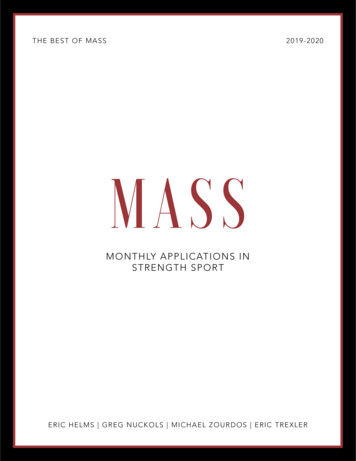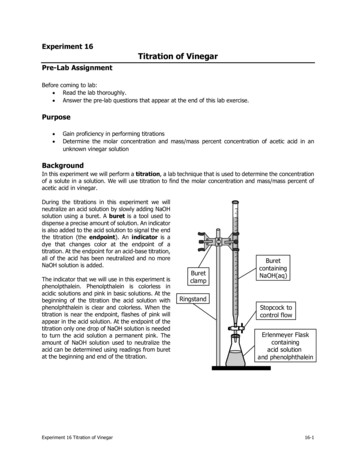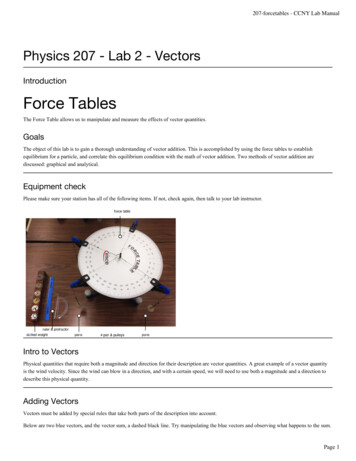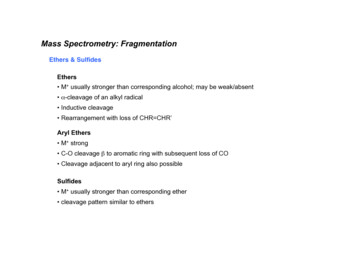
Transcription
T H E B E S T OF MASS201 9 - 2 0 2 0MASSM ONTHLY A PPL ICATIO N S INSTRE N G TH SPO R TE R I C H E LMS G R E G N UCK O LS MIC HAEL ZO URDO S ERIC T REXL E R
The ReviewersEric HelmsEric Helms is a coach, athlete, author, and educator. He is a coach for drug-free strength and physiquecompetitors at all levels as a part of team 3D Muscle Journey. Eric regularly publishes peer-reviewedarticles in exercise science and nutrition journals on physique and strength sport, in addition to writing forcommercial fitness publications. He’s taught undergraduate- and graduate-level nutrition and exercisescience and speaks internationally at academic and commercial conferences. He has a B.S. in fitnessand wellness, an M.S. in exercise science, a second Master’s in sports nutrition, a Ph.D. in strength andconditioning, and is a research fellow for the Sports Performance Research Institute New Zealand atAuckland University of Technology. Eric earned pro status as a natural bodybuilder with the PNBA in 2011 and competes in theIPF at international-level events as an unequipped powerlifter.Greg NuckolsGreg Nuckols has over a decade of experience under the bar and a B.S. in exercise and sports science.Greg earned his M.A. in exercise and sport science from the University of North Carolina at ChapelHill. He’s held three all-time world records in powerlifting in the 220lb and 242lb classes. He’s trainedhundreds of athletes and regular folks, both online and in-person. He’s written for many of the majormagazines and websites in the fitness industry, including Men’s Health, Men’s Fitness, Muscle & Fitness,Bodybuilding.com, T-Nation, and Schwarzenegger.com. Furthermore, he’s had the opportunity towork with and learn from numerous record holders, champion athletes, and collegiate and professionalstrength and conditioning coaches through his previous job as Chief Content Director for Juggernaut Training Systems andcurrent full-time work on StrongerByScience.com.Michael C. ZourdosMichael (Mike) C. Zourdos, Ph.D., CSCS, has specializations in strength and conditioning and skeletalmuscle physiology. He earned his Ph.D. in exercise physiology from The Florida State University (FSU)in 2012 under the guidance of Dr. Jeong-Su Kim. Prior to attending FSU, Mike received his B.S. inexercise science from Marietta College and M.S. in applied health physiology from Salisbury University.Mike served as the head powerlifting coach of FSU’s 2011 and 2012 state championship teams. Healso competes as a powerlifter in the USAPL, and among his best competition lifts is a 230kg (507lbs)raw squat at a body weight of 76kg. Mike owns the company Training Revolution, LLC., where he hascoached more than 100 lifters, including a USAPL open division national champion.Eric TrexlerEric Trexler is a pro natural bodybuilder and a sports nutrition researcher. Eric has a PhD in HumanMovement Science from UNC Chapel Hill, and has published dozens of peer-reviewed researchpapers on various exercise and nutrition strategies for getting bigger, stronger, and leaner. In addition,Eric has several years of University-level teaching experience, and has been involved in coaching since2009. Eric is the Director of Education at Stronger By Science.2
Table of Contents6BY G R EG NUCKOL SUsing Velocity to Autoregulate May Increase Strength GainsWe’ve talked about using velocity to autoregulate training before in MASS, but when the rubber meetsthe road, does autoregulating training using velocity targets and velocity stops ultimately lead to largerstrength gains than percentage-based training? This study says “yes.”16BY M I CHAEL C. ZOUR DOSThe Principle of Specificity Holds True, but Is it All that Matters?This study observed competitive weightlifters undergoing block periodization for seven months.The adaptations tended to be block-specific. So, how can you periodize training but still prioritizespecificity to peak over the long term? This article breaks it down.33BY E RI C HEL MSThe Poptart Problem: Processed Foods and OvereatingIt’s oft-repeated in our community that so long as energy, macros (especially protein), and fiber arematched, the amount of processed food in your diet is inconsequential for body composition. Butis this true when it comes to how such a diet impacts your habitual energy intake and ad libitumconsumption of food?47BY E R I C T R EXL ERUsing Fat-Free Mass Index to Forecast Long-Term Gains for Malesand FemalesAt some point in their lifting career, just about every lifter wonders, “Exactly how big can I get?”While fat-free mass index (FFMI) isn’t going to tell you the exact limit to your potential, or perfectlyweed out steroid-users from drug-free lifters, it’s still a helpful metric for approximating muscularityand understanding how big most people can get. Read this article to figure out how big male andfemale lifters tend to get, and what this means for your natural potential for muscle growth.60BY G R EG NUCKOL SThe Placebo Effect Impacts Performance More Than You Might ExpectThe placebo effect is a well-known psychological phenomenon, but we often forget about it in exerciseresearch. We focus on how much a supplement, device, or treatment improves performance relativeto a placebo, but a lot of the “real-world” improvements in performance may actually be attributableto placebo effects.3
7087BY MI CHAEL C. ZOUR DOSRPE and RIR: The Complete GuideMASS and many others have discussed RPE at length. However, there are many uses of RPEoutside of just basic load prescription. This article gives a brief historical context and thenprovides a section and example of every single way that RPE has been used in the literature.BY E R I C T R EXL ERShedding Some Light on Vitamin D Supplementation: Does It IncreaseStrength In Athletes?Vitamin D deficiency is shockingly common in athletes, and low levels are associated with reducedstrength. A recent meta-analysis suggested that vitamin D supplementation failed to enhancestrength in athletes, but there’s more to this paper than meets the eye. Read on to figure out if vitaminD supplementation might be worth considering.100115117BY G R EG NUCKOL SThe First Clear Evidence of Delayed Hypertrophic SupercompensationThe idea of delayed hypertrophic supercompensation – the idea that your muscles can keep growingfor several days after you complete a grueling block of training – is very contentious. A recent studyprovides us with the first evidence that it’s possible. However, there’s quite a bit more to the story.BY MI CHAEL C. ZOUR DOSVIDEO: All About Plus SetsEverybody seems to program a set or two per week for as many reps as possible (AMRAP) or alsoknown as a plus set. These sets have quite a bit of utility, but they also have some drawbacks and areoftentimes overused. This video covers when to use plus sets and provides strategies to individualizetheir usage.BY ER I C HEL MSVIDEO: Sticking Points – What Do We Know?It is extremely common for powerlifters to focus their training on the “sticking point” in a given liftthrough various methods. But many unanswered questions exist: Why do sticking points occur?Should we even be focusing on them? If so, which strategies have merit? Eric answers thesequestions in this video.4
Letter from the ReviewersWelcome to the 2019-2020 “Best Of ” issue of MASS! Whether this is the firsttime you’re getting a peek inside our research review or you’ve been subscribedsince day 1, we think you’ll love what you find in this special edition of MASS.Since we launched MASS in April 2017, we’ve published 36 issues – that’s about 325articles and videos, 3,000 pages of content, 200 audio roundtable episodes, 700 illustrativegraphics, and 70 hours of video. We offer CEUs for NSCA and NASM and CECs forACSM and ACE. As of April 2020, we have more than 3,500 active subscribers. (Not asubscriber yet? Join here.)What you’ll find in these pages is a glimpse at some of our favorite content from thethird year of MASS, but you can be confident that every issue is packed with rigorouslyexamined and visually stunning reviews of the research that’s most relevant to strength andphysique athletes, coaches, and enthusiasts.If you (or your clients) want to build muscle, get stronger, and/or drop fat as efficientlyand effectively as possible, MASS is for you. We know you want to stay on top of the research, but doing so can be time-consuming, expensive, and confusing. That’s why we doall the heavy lifting for you and distill the most important findings into an easy-to-readmonthly digest.This free issue should give you an idea of what you can expect from MASS. In our writtenpieces, we cover using velocity to autoregulate, the principle of specificity, the link betweenprocessed food and overeating, using fat-free mass index, the placebo effect, RPE and RIR,Vitamin D supplementation, hypertrophic supercompensation, and more.In our unique video content, Mike tells you everything you need to know about plus sets,and Eric Helms examines sticking points.Each issue will tackle new topics like these, keeping you up to date with the current research and giving you a thorough understanding of the best science-based practices. Wehope you enjoy it, and we hope you’ll subscribe so you can stay on the cutting edge of ourfield to get the best results possible for yourself or your clients.Thanks so much for reading.The MASS TeamEric Helms, Greg Nuckols, Mike Zourdos, and Eric Trexler5
Study Reviewed: Comparison of Velocity-Based and Traditional Percentage-BasedLoading Methods on Maximal Strength and Power Adaptations. Dorrell et al. (2019)Using Velocity to AutoregulateMay Increase Strength GainsBY G RE G NUC KO LSWe’ve talked about using velocity to autoregulate training before in MASS,but when the rubber meets the road, does autoregulating training usingvelocity targets and velocity stops ultimately lead to larger strength gainsthan percentage-based training? This study says “yes.”6
KEY POINTS1. Over six weeks, velocity-based training led to significantly larger gains in benchpress strength and jump height than traditional percentage-based training intrained lifters.2. Across four lifts – squat, bench press, overhead press, and deadlift – strengthgains were almost 50% larger with velocity-based training, in spite of the fact thattraining volume was slightly lower.Some days, you hit the gym feelinggreat, and your prescribed workoutbarely challenges you. Other times,you’re tired and fatigued, and your performance in the gym is well below your usual level. Autoregulation strategies, whichwe’ve talked about in MASS many timesbefore (one, two, three, four, five, six), helpyou take advantage of the good days andpull back on the bad days in a logical,controlled manner.One method of autoregulation is via theuse of velocity. As loads increase, meanconcentric velocity decreases in an almost perfectly linear fashion. Because ofthis, you can use velocity as a stand-in fortraditional percentages of 1RM for prescribing intensity. However, percentagesof 1RM don’t change until the next timeyou max, whereas velocity is responsive today-to-day fluctuations in strength, making velocity a prime candidate for autoregulation strategies.However, until now, we didn’t have firmevidence that autoregulating training using velocity actually led to larger strengthgains than training with a traditional percentage-based approach. A recent study(1) found that, in trained subjects, velocity-based training led to significantlylarger increases in jump height and benchpress strength than traditional percentage-based training over six weeks. Thisfinding puts autoregulatory strategies using velocity on a much firmer footing.Purpose and ResearchQuestionsPurposeThe purpose of this study was to compare the effects of velocity-based training and percentage-based training onstrength and power adaptations after asix-week block of training.Listen to Greg Nuckols, Eric Trexler, Eric Helms and MikeZourdos discuss this study in the audio roundtable.Go to playlist in Soundcloud7
Table 1Subject characteristicsAge (years)Body mass (kg)Height (m)Squat (kg)Bench press (kg)Overhead press (kg)Deadlift (kg)22.8 4.589.3 13.3180.2 6.4140.2 26107.7 18.261.3 8.7176.6 27.2Data are mean SDResearch Questions1. Would velocity-based or percentage-based training lead to largerstrength gains in the squat, benchpress, overhead press, and deadliftafter a six-week block of training?2. Would velocity-based or percentage-based training lead to largerincreases in counter-movementjump height after a six-week blockof training?HypothesesNo hypotheses were directly stated, butthe wording of the introduction impliesthat the authors expected that velocity-based training would lead to largergains in strength and counter-movement jump height.Subjects and MethodsSubjectsOf the 30 men that initially volunteered for this study, 3 got injured and11 failed to meet all inclusion criteria,leaving a final sample of 16 subjects.Subjects were required to have at leasttwo years of resistance training experience. They turned out to be a pretty well-trained sample by the standards of mostresearch in the area; the average 1RMsquat was a little over 1.5x bodyweight,and the average deadlift was nearly double bodyweight.DesignThis study took place over approximately seven weeks, with a day of testingpre- and post-training, and six weeks oftraining. The pre-testing day took placeat least 96 hours before the first training session, and the post-testing daytook place at least 96 hours after thelast training session. Testing consistedof counter-movement jump height and1RMs for back squat, bench press, overhead press, and deadlift.Training took place twice per week.Both days included back squat, benchpress, and squat jump. Day 1 also included overhead press, seated rows, andwalking lunges, while day 2 also included deadlifts, plyo push-ups, and barbellhip thrusts. The program itself included two three-week waves, with the firstwave increasing in intensity from 70%1RM to 85-88%, and the second waveincreasing from 80-82% to 95%. Moredetails about the training program canbe seen in Table 2.8
Table 2ExerciseDescriptive characteristics of the base training program* †RepsWeek 1%1RMRepsWeek 2%1RMRepsWeek 3%1RMRepsWeek 4%1RMRepsWeek 5%1RMRepsWeek 6%1RMSession 1Back squat8, 8, 870, 70, 708, 6, 570, 75, 806, 5, 375, 80, 858, 6, 570, 75, 806, 5, 378, 85, 905, 3, 2 85, 90, 95Bench press8, 8, 870, 70, 708, 6, 570, 75, 806, 5, 375, 80, 858, 6, 570, 75, 806, 5, 378, 85, 905, 3, 2 85, 90, 95BB squat jump2 (3), 2 (3)Strict OHP8, 8, 8BM70, 70, 702 (3), 2 (3)8, 6, 5BM70, 75, 802 (3), 2 (3)6, 5, 3BM2 (3), 2 (3)75, 80, 858, 6, 5BM70, 75, 802 (3), 2 (3)6, 5, 3BM78, 85, 90DeadliftSeated row6, 6, 6Walking Lunge10, 10, 102 RIR6, 6, 62 RIR10, 10, 106, 6, 62 RIR6, 6, 610, 10, 102 RIR10, 10, 106, 6, 65, 3, 2 85, 90, 955, 3, 2 85, 90, 952 RIR10, 10, 10Session 2Back squat8, 8, 870, 70, 708, 6, 570, 75, 806, 5, 3 75, 83, 888, 6, 570, 75, 826, 4, 278, 88, 924, 4, 470, 70, 70Bench press8, 8, 870, 70, 708, 6, 570, 75, 806, 5, 3 75, 83, 888, 6, 570, 75, 826, 4, 278, 88, 924, 4, 470, 70, 70BB squat jump2 (3), 2 (3)4, 4, 470, 70, 704, 4, 470, 70, 70BM2 (3), 2 (3)BM2 (3), 2 (3)BM2 (3), 2 (3)BM2 (3), 2 (3)BMStrict OHPDeadlift8, 8, 870, 70, 708, 6, 570, 75, 806, 5, 375, 80, 858, 6, 570, 75, 806, 5, 378, 85, 90Plyo push-up2 (3), 2 (3)BM2 (3), 2 (3)BM2 (3), 2 (3)BM2 (3), 2 (3)BM2 (3), 2 (3)BMBB hip thrust8, 8, 8 BM8, 8, 8 BM8, 8, 8 BM8, 8, 8 BM8, 8, 8 BM*RM repetition maximum; BB barbell; 2 (3) cluster set, 2x3 repetitions; BM body mass; OHP overhead press; RIR repetitions in reserve; Plyo plyometric; BM completed with body mass on the barbell† walking lunge load calculated (Ebben et al., 2008): 0.6 (6RM squat [kg; 0.52] 14.82kg)One group used a percentage-basedprogram, and one group used a velocity-based program. The percentage-basedprogram is the one in Table 2. In orderto equate the two programs, the velocity-based group used velocity zones andvelocity stops, rather than percentagesand prescribed numbers of reps. Loadswere dictated by the subject’s performance on each training day with the velocity-based program, so that when theirvelocities were higher or lower thannormal, they could train with heavier orlighter loads to stay in the correct velocity range.It’s not entirely clear how the velocity zones were defined in this study; theauthors note that “group zones for eachmovement were created using a combination of previously published dataand data collected within the pretesting1RM assessments,” but no additional information is provided about how thosetwo data sources were integrated or howthey determined the size of each range.The velocity stops are a bit ambiguousas well. The authors state “velocity stopswere integrated into each set at 20% below the target velocity of each specificzone.” They cite this paper (which waspreviously reviewed in MASS) as a reference (2), and in that study, they terminated each set when velocity dropped bymore than 20% from the first rep in theset. I think that’s what they did in thisstudy. However, that statement couldalso be interpreted to mean that each setwas terminated when velocity fell 20%below the bottom end of the target velocity range.That’s a non-negligible distinction,because their velocity targets seem tobe fairly wide. For example, the velocitytarget for the squat to correspond to 70%1RM was 0.74-0.88 m/s. If the velocitystop kicked in when rep speed droppedby 20% within a set, then someonewhose first rep was 0.88m/s would terminate a set when their velocity droppedto 0.70m/s, and someone whose first repwas 0.74m/s would terminate a set whentheir velocity dropped to 0.59m/s. If the9
velocity stop kicked in when rep speeddropped to 20% below the bottom of thetarget range, then each squat set in thisintensity range would terminate at a velocity of 0.59m/s, regardless of where thefirst rep fell in the 0.74-0.88m/s range.I’ll admit that I may just be being abit too pedantic, since I’m sure I coulddo a bang-up job of approximating theirtarget velocity ranges for each intensity,and since both potential interpretationsof their velocity stop method wouldprobably be fine in practice. However,for a study that’s this novel in the literature, I’d really like to know exactlyhow the velocity-based program was executed, but the methods section doesn’tprovide me with enough information toknow exactly how they prescribed loadsand how they decided when to terminate each set.FindingsBoth groups got significantly strongerin the squat, bench press, and overheadpress. Only the velocity-based group gotsignificantly stronger in the deadlift. Additionally, only the velocity-based grouphad a significant increase in counter-movement jump height. There wereonly significant between-group differences for the bench press and counter-movement jump. Overall, the velocity-based group added an average of37.3kg to their four main lifts, while thepercentage-based group added 25.1kg.NOW THAT WE CAN SEETHAT USING VELOCITY TOASSIGN TRAINING LOADSACTUALLY LEADS TO FASTERSTRENGTH GAINS THANUSING PERCENTAGES, THATLETS US KNOW THAT ALLOF THAT WORK FLESHINGOUT THE LOAD-VELOCITYLITERATURE WASN’T IN VAIN.Interestingly, volume load (sets x repsx weight) was slightly – though significantly – lower in the velocity-basedgroup for the squat, bench press, andoverhead press. The overall difference involume load was small (5.9%), but thevelocity-based group was a little stronger at baseline ( 8.4% stronger), so relative volume load (sets x reps x %1RM)was closer to 19% lower in the velocity-based group.InterpretationThis was a really cool study that wasmuch-needed. In the past decade, there’s10
Figure 1Mean changes in back squat, bench press, strict overhead press, and deadlift 1RM and counter-movement jump after 6 weeks of trainingOverhead pressBench ad (kg)Load (kg)Load (kg)110200PBTTraining group403550100457060VBTTraining groupPBTTraining ermovement 9065120Pre-training21020070Load (kg)190220Height (cm)Back squatDeadlift80VBTPBTTraining groupVBTPBTTraining group* significant difference pre vs. post; ** significant group by time effectbeen a lot of work digging into load-velocity profiles. We’ve reviewed severalload-velocity papers for MASS already(one, two, three, four, five, six). However, with any new form of monitoring,or new way to assign training loads, themost important question is, “does thisactually matter?” If it doesn’t ultimatelyhelp people reach their goals more effectively and efficiently, it’s ultimatelyjust mental masturbation and overcomplication for the sake of feeling more incontrol. Now that we can see that usingvelocity to assign training loads actuallyleads to faster strength gains than usingpercentages, that lets us know that all ofthat work fleshing out the load-velocityliterature wasn’t in vain (assuming theseresults replicate).With that being said, I do have a fewreservations about these results. First,this study was just six weeks long. Yes,that’s a cheap critique, and I don’t holdthat against the authors (that’s still aTON of work), but it’s at least worthconsidering the possibility that resultswould have been different if the studyran longer. More substantially, I thinkthere was an important confoundingvariable in this study: The subjects in thevelocity-based group were told their velocity for each rep. Some research suggests that intentionally moving the baras fast as possible leads to larger strengthgains, and velocity feedback improvesacute performance (3, 4). An assumption with velocity-based training is thatyou move each rep as fast as you can. If11
Table 3Volume load (kg)Relative volume loadVelocity-basedPercentage-basedPercent differenceVelocity-basedPercentage-basedPercent differenceBack squat1148961250108.8%777.4947.821.9%Bench press1174571239825.6%1060.11319.024.4%Overhead 847.419.0%Relative volume load volume load / pre-training 1RMyou don’t, your velocity data is essentiallyworthless, since all of the ways you canprescribe training using velocity is predicated on the linear relationship betweenload and velocity, and between proximity to failure and velocity when maximumeffort is exerted. Thus, the velocity-basedgroup a) knew (or at least should haveknown) that they really needed to putforth their full effort on each rep tomake the velocity-based load and volume prescriptions work in the first place,and b) the velocity feedback on each repessentially functions as external cuing(reminding you to move the bar fast). AsMASS readers should know by now, external cueing improves performance (5).Thus, the superior strength gains in thevelocity-based group may have been dueto the velocity-based training, but theymay have been at least partially due tothe constant velocity feedback. However, that may be a distinction withouta difference, as velocity-based trainingdoes force you to stay intimately aware ofyour velocity on each rep and does forceyou to move each rep as fast as possible,neither of which are typical (and certain-ly not required) for percentage-basedprograms.With that being said, I’m less skepticalof these results than I would be if velocity-based training didn’t have strongtheoretical underpinnings. The idea justmakes sense: On days you’re strong, avelocity-based approach will allow youto train with heavier loads or do morevolume, and on days you’re weak and under-recovered, a velocity-based approachwill have you pull back on your trainingloads and/or volume to allow you to recuperate. Over time, those small marginal advantages in each session, resulting from improved matching of trainingstress and readiness, should lead to betterresults. I do think the 50% faster average strength gains with velocity-basedtraining in this study is pretty unrealistic(I think the effect they found is correct,but the relative magnitude of the effect islarger than the “true” magnitude), especially since the study ran just six weeks.I do think the theory is sound, though,and I feel even better about it now thatit’s been directly tested.12
ON DAYS YOU’RE STRONG, AVELOCITY-BASED APPROACHWILL ALLOW YOU TO TRAIN WITHHEAVIER LOADS OR DO MOREVOLUME, AND ON DAYS YOU’REWEAK AND UNDER-RECOVERED, AVELOCITY-BASED APPROACH WILLHAVE YOU PULL BACK ON YOURTRAINING LOADS AND/OR VOLUMETO ALLOW YOU TO RECUPERATE.One thing to note is that the load prescription in this study could have beeneven more individualized. The authorsused group velocity targets for each liftand intensity, whereas individualizedtargets would be easy to figure out, andwould do an even better job of personalizing load prescriptions. I understandthe decision completely: it would be aHUGE pain in the ass to come up withindividualized velocity targets for eachlift, each intensity, and each subject (4 exercises x 9 different intensity targets x 16subjects 576 velocity targets you needto calculate and keep track of, withoutmaking mistakes during data collection),but it’s entirely realistic for two individ-uals to move the bar at speeds that differby 0.1-0.2m, even when performing thesame exercise at the same intensity. Basically, if you put all training programson a continuum from maximally rigidto maximally autoregulated, the methodof assigning loads to the velocity-basedgroup in this study would certainly bemuch closer to the maximal autoregulation pole than the maximal rigidity pole,but it could get even more personalizedand autoregulation-y.If you saw this study in a vacuum, itmay surprise you. After all, the traditional group trained with higher absolute volume loads (and even higher relative volume loads) but still managed togain less strength. However, results likethis should be familiar to MASS readers. Mike covered a study a while backshowing that terminating each set aftera 20% velocity loss led to larger gains injump height and possibly larger strengthgains than terminating each set after a40% velocity loss, even though volumeload was way lower in the 20% velocityloss group (2). For that study, I suggestedthat perhaps the 40% velocity loss groupwas just more fatigued at post-testing.However, that explanation doesn’t fly inthis study. The second workout of week6 is intentionally easy (2 sets of 3 with70% 1RM), and post-testing didn’t takeplace until at least 96 hours after the lasttraining session, so both groups rolledinto post-testing after about a week ofdeloading. So, how can you equate for13
APPLICATION AND TAKEAWAYSIf you have a device for measuring bar velocity, you may be able to use velocity targetsand velocity stops to create a training program that is more responsive to you andthat will ultimately lead to faster strength gains. If you don’t, RPE stops and RPE loadtargets may work just as well, given the emerging work on RPE programs, which Mikereviewed this month.intensity, have a lower volume load, andstill make larger strength gains? Intensity is the primary driver of strength gains(6), and I think that staying further fromfailure during training helps ensure thatsubsequent workouts are also high quality.either group (i.e. the researchers wouldbe watching the velocities to know whenan appropriate load has been reached,and would tell their velocity-based subjects when to cut a set and rack the barbased on velocity loss criteria).If you’re interested in making yourown load-velocity profile and havingyour own personalized velocity targets,you can make a copy or download thisspreadsheet (do not request editing access) which will do most of the heavylifting for you, as long as you have a device you can use to measure velocity inthe first place.Next StepsAs I mentioned, I think the velocityfeedback in one group and not the other could have biased the results of thisstudy a bit. To remedy that, future studies should either a) provide velocity feedback to both groups or b) simply havethe researchers encourage both groupsto move every rep as fast as possible,without providing velocity feedback to14
References1. Dorrell HF, Smith MF, Gee TI. Comparison of Velocity-Based and Traditional Percentage-BasedLoading Methods on Maximal Strength and Power Adaptations. J Strength Cond Res. 2019 Feb 18.2. Pareja-Blanco F, Rodríguez-Rosell D, Sánchez-Medina L, Sanchis-Moysi J, Dorado C, Mora-Custodio R, Yáñez-García JM, Morales-Alamo D, Pérez-Suárez I, Calbet JAL, González-Badillo JJ.Effects of velocity loss during resistance training on athletic performance, strength gains and muscleadaptations. Scand J Med Sci Sports. 2017 Jul;27(7):724-735.3. González-Badillo JJ, Rodríguez-Rosell D, Sánchez-Medina L, Gorostiaga EM, Pareja-Blanco F.Maximal intended velocity training induces greater gains in bench press performance than deliberately slower half-velocity training. Eur J Sport Sci. 2014;14(8):772-81.4. Nagata A, Doma K, Yamashita D, Hasegawa H, Mori S. The Effect of Augmented Feedback Typeand Frequency on Velocity-Based Training-Induced Adaptation and Retention. J Strength CondRes. 2018 Feb 14.5. Wulf G. Attentional focus and motor learning: a review of 15 years. International Review of Sportand Exercise Psychology 2013 6:1, 77-1046. Schoenfeld BJ, Grgic J, Ogborn D, Krieger JW. Strength and Hypertrophy Adaptations BetweenLow- vs. High-Load Resistance Training: A Systematic Review and Meta-analysis. J Strength CondRes. 2017 Dec;31(12):3508-3523. 15
Study Reviewed: Phase-Specific Changes in Rate of Force Development and MuscleMorphology Throughout a Block Periodized Training Cycle in Weightlifters. Suarez et al. (2019)The Principle of Specificity HoldsTrue, But Is It All That Matters?BY MIC HAE L C . ZO URD O SThis
magazines and websites in the fitness industry, including Men’s Health, Men’s Fitness, Muscle & Fitness, Bodybuilding.com, T-Nation, and Schwarzenegger.com. Furthermore, he’s had the opportunity to work with and learn from numerous record ho











